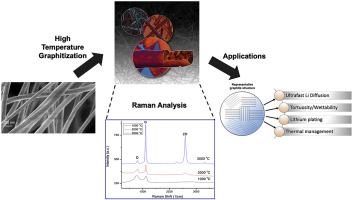当前位置:
X-MOL 学术
›
Mater. Today Chem.
›
论文详情
Our official English website, www.x-mol.net, welcomes your
feedback! (Note: you will need to create a separate account there.)
Finetuning hierarchical energy material microstructure via high temperature material synthesis route
Materials Today Chemistry ( IF 6.7 ) Pub Date : 2020-06-01 , DOI: 10.1016/j.mtchem.2020.100269 K. Mondal , G. Pawar , M.D. McMurtrey , A. Sharma
Materials Today Chemistry ( IF 6.7 ) Pub Date : 2020-06-01 , DOI: 10.1016/j.mtchem.2020.100269 K. Mondal , G. Pawar , M.D. McMurtrey , A. Sharma

|
Abstract Hierarchical energy materials such as graphite are a backbone of various scientifically and commercially important emerging technologies including high-energy density energy storage systems with fast charging capability, multifunctional catalyst systems, selective membrane separation systems, and next-generation nuclear material systems. Consequently, it is extremely crucial to develop an efficient and cost-effective route of bulk hierarchical material synthesis (e.g., carbonaceous materials with a well-controlled fraction of the graphitic content) to cater the extraordinary operational and energy material requirements in a very complex coupled thermophysicochemical environment. Here we present a fabrication of Polyacrylonitrile (PAN) derived carbon films and fibers (~with linear dimension ~100 nm) via electrospinning and spin coating methods ensued by a heat-treatment in the range of 1000–3000 °C under inert atmospheric conditions. Intriguingly, we observed at least a two orders of magnitude enhancement (~134%) in length of graphitic plane accompanied by 36% more graphitization when the carbonization temperature increased from 1000 °C to 3000 °C. Such significant enhancements were attributed to the differences in the fundamental nanomorphology of initial carbonaceous materials and their subsequent kinetic evolution as it was more favorable for underlying graphene layers in films to stack and bond to the adjacent ones without strong rotations as compared to fibers, which were further evident from fewer voids and cracks in the films. The covalent cross-links, substrate effect and physical entanglements of carbon domains in PAN-derived carbon films contributed to a higher graphitic length owing to more shear stress between the graphene layers, compared to fibers and undergoes an enormous transformation from turbostratic structures to ordered state along with nitrogen removing over high temperature heating. This morphology dependent graphitization was also investigated from computational approach and concluded in the similar thoughts. The outcomes from this systematic study can be beneficial to the carbon research community focusing in the morphology dependent applications, for instance catalysis, energy storage, sensors etc.
中文翻译:

通过高温材料合成路线微调分级能源材料微观结构
摘要 石墨等多级能源材料是各种科学和商业上重要的新兴技术的支柱,包括具有快速充电能力的高能量密度储能系统、多功能催化剂系统、选择性膜分离系统和下一代核材料系统。因此,开发一种高效且具有成本效益的批量分级材料合成路线(例如,石墨含量控制良好的碳质材料)以满足非常复杂的耦合中的非凡操作和能源材料需求至关重要。热物理化学环境。在这里,我们通过静电纺丝和旋涂方法制造聚丙烯腈(PAN)衍生的碳膜和纤维(~线性尺寸~100 nm),随后在惰性大气条件下在 1000-3000°C 范围内进行热处理。有趣的是,当碳化温度从 1000°C 增加到 3000°C 时,我们观察到石墨平面的长度至少增加了两个数量级(~134%),同时石墨化程度增加了 36%。这种显着的增强归因于初始碳质材料的基本纳米形态及其随后的动力学演变的差异,因为与纤维相比,薄膜中的底层石墨烯层更有利地堆叠并粘合到相邻的石墨烯层而没有强旋转,从薄膜中较少的空隙和裂缝可以进一步证明这一点。与纤维相比,PAN 衍生的碳膜中碳域的共价交联、底物效应和物理缠结导致更高的石墨长度,因为石墨烯层之间的剪切应力比纤维更大,并且经历了从乱层结构到有序状态的巨大转变随着高温加热脱氮。还从计算方法研究了这种依赖于形态的石墨化,并以类似的想法得出结论。这项系统研究的结果对专注于形态相关应用(例如催化、能量存储、传感器等)的碳研究界有益。与纤维相比,由于石墨烯层之间的剪切应力更大,PAN 衍生的碳膜中碳域的底物效应和物理缠结导致更高的石墨长度,并且经历了从乱层结构到有序状态的巨大转变以及高氮去除温度加热。还从计算方法研究了这种依赖于形态的石墨化,并以类似的想法得出结论。这项系统研究的结果对专注于形态相关应用(例如催化、能量存储、传感器等)的碳研究界有益。与纤维相比,由于石墨烯层之间的剪切应力更大,PAN 衍生的碳膜中碳域的底物效应和物理缠结导致更高的石墨长度,并且经历了从乱层结构到有序状态的巨大转变以及高氮去除温度加热。还从计算方法研究了这种依赖于形态的石墨化,并以类似的想法得出结论。这项系统研究的结果对专注于形态相关应用(例如催化、能量存储、传感器等)的碳研究界有益。与纤维相比,经历了从乱层结构到有序状态的巨大转变,同时在高温加热下脱氮。还从计算方法研究了这种依赖于形态的石墨化,并以类似的想法得出结论。这项系统研究的结果对专注于形态相关应用(例如催化、能量存储、传感器等)的碳研究界有益。与纤维相比,经历了从乱层结构到有序状态的巨大转变,同时在高温加热下脱氮。还从计算方法研究了这种依赖于形态的石墨化,并以类似的想法得出结论。这项系统研究的结果对专注于形态相关应用(例如催化、能量存储、传感器等)的碳研究界有益。
更新日期:2020-06-01
中文翻译:

通过高温材料合成路线微调分级能源材料微观结构
摘要 石墨等多级能源材料是各种科学和商业上重要的新兴技术的支柱,包括具有快速充电能力的高能量密度储能系统、多功能催化剂系统、选择性膜分离系统和下一代核材料系统。因此,开发一种高效且具有成本效益的批量分级材料合成路线(例如,石墨含量控制良好的碳质材料)以满足非常复杂的耦合中的非凡操作和能源材料需求至关重要。热物理化学环境。在这里,我们通过静电纺丝和旋涂方法制造聚丙烯腈(PAN)衍生的碳膜和纤维(~线性尺寸~100 nm),随后在惰性大气条件下在 1000-3000°C 范围内进行热处理。有趣的是,当碳化温度从 1000°C 增加到 3000°C 时,我们观察到石墨平面的长度至少增加了两个数量级(~134%),同时石墨化程度增加了 36%。这种显着的增强归因于初始碳质材料的基本纳米形态及其随后的动力学演变的差异,因为与纤维相比,薄膜中的底层石墨烯层更有利地堆叠并粘合到相邻的石墨烯层而没有强旋转,从薄膜中较少的空隙和裂缝可以进一步证明这一点。与纤维相比,PAN 衍生的碳膜中碳域的共价交联、底物效应和物理缠结导致更高的石墨长度,因为石墨烯层之间的剪切应力比纤维更大,并且经历了从乱层结构到有序状态的巨大转变随着高温加热脱氮。还从计算方法研究了这种依赖于形态的石墨化,并以类似的想法得出结论。这项系统研究的结果对专注于形态相关应用(例如催化、能量存储、传感器等)的碳研究界有益。与纤维相比,由于石墨烯层之间的剪切应力更大,PAN 衍生的碳膜中碳域的底物效应和物理缠结导致更高的石墨长度,并且经历了从乱层结构到有序状态的巨大转变以及高氮去除温度加热。还从计算方法研究了这种依赖于形态的石墨化,并以类似的想法得出结论。这项系统研究的结果对专注于形态相关应用(例如催化、能量存储、传感器等)的碳研究界有益。与纤维相比,由于石墨烯层之间的剪切应力更大,PAN 衍生的碳膜中碳域的底物效应和物理缠结导致更高的石墨长度,并且经历了从乱层结构到有序状态的巨大转变以及高氮去除温度加热。还从计算方法研究了这种依赖于形态的石墨化,并以类似的想法得出结论。这项系统研究的结果对专注于形态相关应用(例如催化、能量存储、传感器等)的碳研究界有益。与纤维相比,经历了从乱层结构到有序状态的巨大转变,同时在高温加热下脱氮。还从计算方法研究了这种依赖于形态的石墨化,并以类似的想法得出结论。这项系统研究的结果对专注于形态相关应用(例如催化、能量存储、传感器等)的碳研究界有益。与纤维相比,经历了从乱层结构到有序状态的巨大转变,同时在高温加热下脱氮。还从计算方法研究了这种依赖于形态的石墨化,并以类似的想法得出结论。这项系统研究的结果对专注于形态相关应用(例如催化、能量存储、传感器等)的碳研究界有益。











































 京公网安备 11010802027423号
京公网安备 11010802027423号